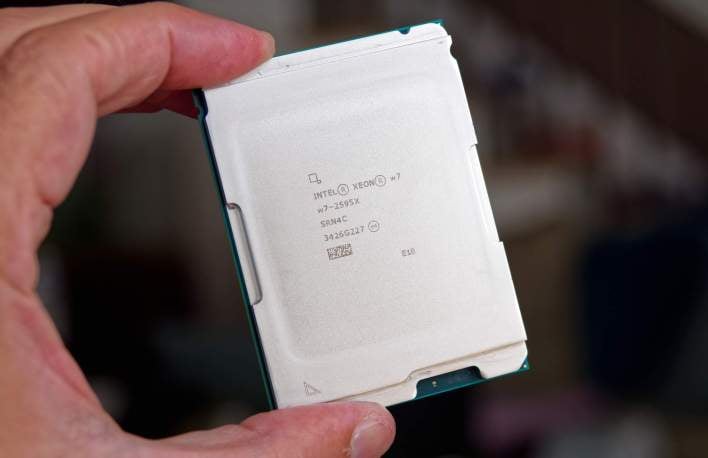
| Intel Xeon w7-2595X – MSRP $2,039 The Intel Xeon w7-2595X is a new powerful 26-core processor for developers or workstation professionals who require massive memory capacity, bandwidth and performance.
|
|||

|


|
||
Intel today updates its Xeon W processor line for professional workstations, offering a variety of models with core counts ranging from 8 to 60 cores. The new Xeon W-3500 and W-2500 replace last year’s Xeon W-3400 and W-2400 series, but fundamentally the processors are quite similar. Both generations are based on Intel’s Sapphire Rapids platform and all offer P-core designs based on the Golden Cove microarchitecture. However, the new Xeon W-3500 and W-2500 offer a higher core count as well as optimized frequencies and power management to optimize performance.
We’ve got the top of the line Xeon W-2500 series processor in hand, the Xeon w7-2595X, and we’re about to test it out. Before we get into the numbers though, let’s get into the details of Intel’s new Xeon W-series and see what the company has in store for workstation professionals…

The Intel Xeon W-2500 series processors offer up to 26 cores, while the higher-end W-3500 series offers up to 60 cores. Both series of Xeon W processors use the same chipsets and motherboards and fit into the same LGA 4677 socket, but offer different IO configurations and of course different core counts. In terms of features, however, the Xeon W-3500 and W-2500 series are similar. They offer support for Intel AMX (Advanced Matrix Extensions), AVX-512, and support up to 4 TB of memory with support for up to 8 channels for massive potential bandwidth. The processors also offer up to 112 lanes of PCIe Gen 5 connectivity when paired with the W790 chipset, as well as Intel vPro technology and all the advanced network interfaces you’d expect from a modern workstation platform.
These last points are what differentiate the Xeon W platform from traditional desktop processors. In addition to the higher core count and all P-Core configurations, what sets it apart from traditional desktops is the ability to pack tons of memory and PCIe devices into a Xeon W system. While the massive memory capacities and higher maximum memory bandwidth don’t come into play in every type of workload, when they do, they can have a significant impact on performance.
The Intel Xeon W-2500 and W-3500 processor series
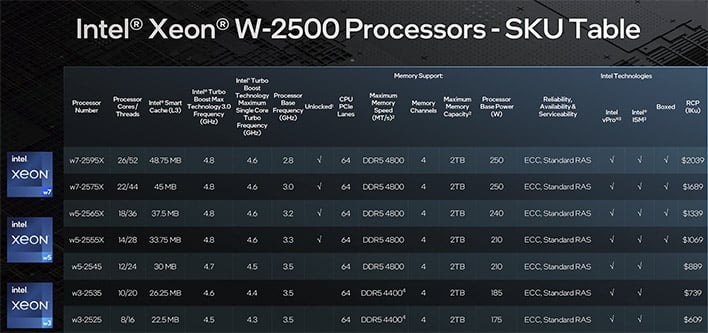
The Xeon W-2500 series consists of a single monolithic chip based on Intel 7. Although a similar chip on Intel’s Emerald Rapids-based Xeon server processors offers up to 32 cores, the top of the Xeon W-2500 series has 26 cores – two more cores than the previous generation Xeon w7-2495X. The Xeon W-2500 series processors also support up to quad-channel memory with a maximum of 2 TB and up to 64 PCIe Gen 5 lanes. The Xeon w7-2595X we’re showing you here has 48.75 MB of L3 Smart Cache, with that number decreasing as the core count decreases. Frequencies and cache configurations for the line are listed in the table above.
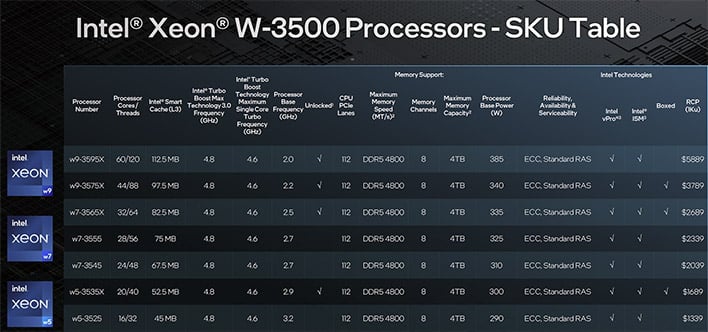
The Xeon W-3500 series offers essentially twice as much of everything as the Xeon W-2500. The Xeon W-3500 series processors consist of two chips (or tiles or chiplets), with the top-end SKU offering 60 P-cores, 112 PCIe Gen 5 lanes, and support for up to 4 TB of memory in an 8-channel configuration. The L3 cache is limited to 112.5 MB.
All Xeon W-series processors require DDR5 RDIMMs, similar to AMD’s latest Threadripper 7000 processors, with the maximum officially supported speed of DDR5-4800, although much higher speeds are possible. When looking at the SKU stacks, note that the Xeon W-2500 series processors range from 8-26 core configurations, while the Xeon W-3500 series processors range from 16-60 cores. And since all of these cores are P-cores, they support HyperThreading, allowing each core to handle two threads simultaneously.
Introducing: The Xeon w7-2595X
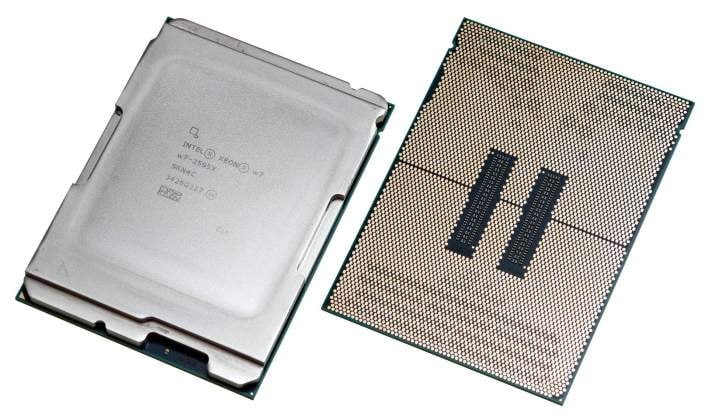
The Xeon W-3500 series processors are similarly sized and have the same LGA 4677 pad configuration on the bottom, but the notches in their heat spreaders are different and each requires special CPU protection when installed into a motherboard. We describe the build process in detail and show you the differences in this build video.
Xeon W processors are much larger than traditional desktop chips. When installed into a socket, the processors must first be secured in a CPU protector, which is then connected to the cooling solution used. At first glance, this seems like an odd way to do it, and is the opposite of traditional desktop CPU installation, where the chip simply drops into the socket and is locked in place with a lever, but in practice it’s pretty straightforward. Over the course of this test, we swapped processors four times and had no issues with fit or cooler installation. If you’re building a rig around a Xeon W processor, be sure to check out this video so you understand exactly what we mean.
Intel W790 motherboard and RDIMM memory
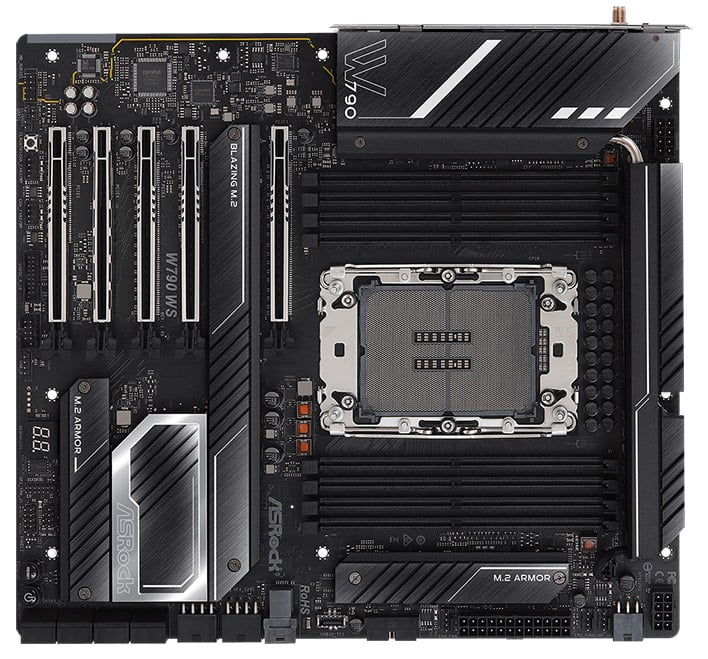
Intel Xeon W processors require motherboards based on the Intel W790 chipset. Motherboards that were compatible with the Xeon W-2400 and W-3400 series should also be compatible with the new W-2500 and W-3500 series, provided the manufacturer has updated the board’s BIOS/UEFI with the required microcode. We can confirm that the Xeon w7-2595X works with the latest public BIOS available for the ASUS Pro WS W790-ACE, and the ASRock W790 WS also has support. (All current W790 motherboards should do this)
All of the W790-based motherboards currently available are decidedly high-end options built with ultimate connectivity and reliability in mind. However, when purchasing a W790 motherboard, pay attention to the motherboard specifications, especially if you’re considering a Xeon W-3500 series processor. Many W790 motherboards support quad-channel memory, but few support the full eight-channel configurations for Xeon W-3500s. This doesn’t matter for Xeon W-2500 series processors, which have a maximum of four channels, but if you want to get the most out of a Xeon W-3500, an eight-channel configuration is the way to go.
We also want to show you all the memory we used for testing. We used some G-SKILL Zeta R5 Neo RDIMM memory in our review unit, specifically the 64GB F5-6400R3239G16GQ4-ZR5K Quad Channel kit.
G.SKILL currently offers some Zeta R5 RDIMM kits in four- and eight-channel variants for Intel Xeon W processors and AMD Threadripper 7000. The kit we used consists of four matching 16GB memory sticks, which add up to a total of 64GB in a 4-channel configuration.
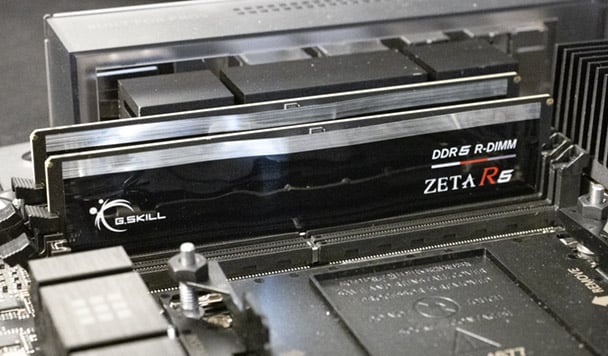
This memory can run at 6400 MT/s and CL32-39-39-102 timings at 1.4V, but we ran it at each platform’s maximum rated memory speed without overclocking (DDR5-4800 to DDR5-5200, depending on the platform). The memory supports ECC and, depending on the specific kit, XMP or EXPO is also supported.
At first glance, it may look like these memory sticks have plain black and silver shiny heatsinks, but that’s not the case. The branding on the RDIMMs is simply a sticker and has no real mass to help with cooling.
Intel Xeon w7-2595X CPU-Z Details
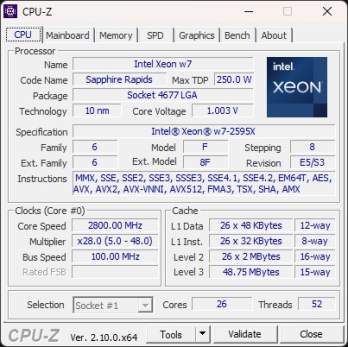
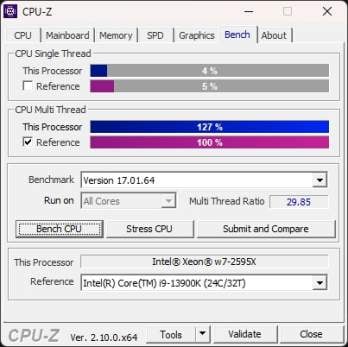
A quick look at CPU-Z shows some of the inner workings of the Xeon w7-2595X. The processor has a base clock speed of 2.8GHz (with a Turbo Boost Max 3.0 clock speed of 4.8GHz and a single-core turbo of 4.6GHz) at a maximum TDP of 250W, although the power peak will be higher in some workloads. There is 48KB L1 data cache (12x), 32KB L1 instruction cache (8x), and 2MB L2 cache (16x) per core, with 48.75MB L3 cache (15x).
